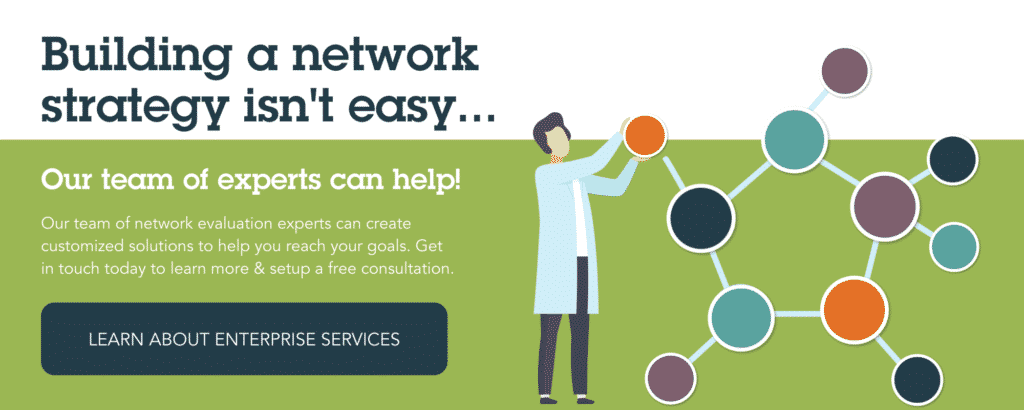Don’t Fall for These 5 Network Myths

Common misconceptions and myths are everywhere these days: Wait 30 minutes before swimming after a meal – convincing, but also unnecessary according to science. The Five Second Rule? Less about keeping us safe, and more about making us feel safe. So why can’t we get over these seemingly accurate falsehoods? Most common myths have a seed of truth or common sense that make it hard to deny them, even with science to back you up. Network science isn’t immune from this problem either! There are dozens of network myths that continue to stick around, despite the best evidence to the contrary. Here are five Network Myths you may have heard before, along with what the science really says:
Myth 1: There is a single list of network best practices
Reality: The best practices for your network depends entirely on its context and community. How the network formed, who it’s composed of, and what they’ve done in the past; these all influence the “best” way to manage and grow it today. In fact, one of VNL’s seven values that guide network leadership is community and context-specificity. Instead of searching for a single list of best practices, get to know your network better and experiment to find what works for your situation. Then, build a set of skills that allow you to be reflective and adaptive to the changes and nuances that occur every day among your network members (Our Learning Lab can help with that!) Knowing about frameworks is good, but should be taken as suggestions and helpful guideposts. Always keep an open, agile mind when working in networks, or you are bound to get frustrated.
Myth 2: Everyone wants to be a part of every meeting, so they don’t feel left out.
Reality: People are busy, and organizations are even busier. While FOMO is a real feeling in a lot of circumstances, it turns out that one of the surest ways to suck up all of your network resources really quickly is to ask every member to attend as many meetings as possible. What people really need is to know that they have the option to attend, but are guided by knowing when their involvement is more necessary than other times. Assign each member of your network a role, based on the value and unique skills they bring to your network. Only require them to attend meetings when they will play that role and contribute in unique ways. Otherwise, take good notes, distribute them, and give members an out that lets them know you understand their time is valuable and you plan to respect it. Inviting members to everything creates an obligation to attend, and quickly leads to burn-out, limiting your growth and success.
Myth 3: The more integrated our work, the better!
Reality: A common mistake in networks is pushing the “more is better” mantra. More partnerships, meetings more often, with as much integration among people and programs as possible. Well, there isn’t enough time or energy in the world to integrate your operations with all your partners. There are other ways to develop network ties – from cooperation, coordination, to integration. To be strategic, you have to use your relationship budget wisely, and focus your efforts on establishing key partnerships in your network at the level that is the best use of resources. Integrate only where absolutely necessary, track these processes (using tools like social network analysis) and then map them to goals and outcomes, and you’ll start to intuitively know where the right balance is for your network. Learn more about our network analysis tools here.
Myth 4: Network members with the most power & influence will be the best leaders for the network.
Reality: The most influential and powerful organizations are often also the busiest; it’s usually the case that they lack the time to be the sole leader and organizer for the network. Yet, they are almost always the organizations that are asked to lead networks. Alternatively, look for partners that contribute value in other ways, like a high level of involvement or resource contribution, and ask them to help take on leadership of the network. These “unusual suspects” are more likely to be interested in leading networks, as the role is likely more unique and novel for them, and quite possibly, something they have time for. Not all partners supply value in the same way so be sure to leverage all the different types of value they’re bringing to the network.
Myth 5: Frequent communication among members is a sign of strong networks
Reality: Just like in our everyday lives, frequent communication can help build and maintain a relationship, but it is not always true that this level of contact is required to strengthen a relationship. Some of our strongest and most intimate relationships are with people we infrequently connect with, including our family, best friends, college classmates, etc. Instead of focusing on the quantity of interactions, work on building the quality of your interactions to build trust for those rare moments you do work together.

About the Author: Alex Derr, M.P.A.
Director of Marketing & Communications
Alex joined VNL in 2017, originally supporting our events. He now helps manages our communications and marketing strategy and content development work. Alex creates blogs, infographics, reports, and other content while managing our web and social media presence. He also runs our email marketing campaigns, tracks analytics, and conducts market research to drive our strategy. He supports our entire team with copywriting, graphic design and research, and helps with events, webinars, demos, and other online learning. When he isn’t at work Alex spends his time climbing 14ers (30 done, 28 to go!) and blogging on his own website, The Next Summit Blog.





